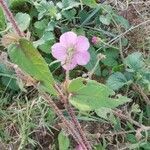Leaf-lamina 3–20 cm. in diam., suborbicular-cordate in outline, the lower surface usually more densely pubescent than the usually ± scabrid upper surface, usually 3–5-lobed; lobes triangular, acute and coarsely serrate-dentate; petiole 0·4–7 cm. long, usually fairly uniform in length in one specimen; stipules c. 5 mm. long (occasionally longer), filiform, usually caducous.
Flowers pale pink to mauve or rather deep mauve-red, in subsessile clusters or in pedunculate few-flowered inflorescences, occasionally solitary, in the upper leaf-axils of the main branches and also sometimes on axillary short shoots; peduncle up to 5 cm. long; pedicels usually very short but up to 7 cm. long in some flowers.
Erect suffrutex or shrub, 1–3 m. tall, usually densely pubescent on stems and leaves, sometimes also with longer soft hairs and/or with coarse harsh and slightly pungent hairs (the latter causing a slight irritation of the skin) but indumentum varying from pubescent to densely to sparsely tomentose-velutinous.
A rambling shrub. The stems are soft. It grows 3 m tall. The stems and leaves are hairy. These can cause itching when touched. The flowers are purplish-red. The plant can vary in hairiness, leaf shape and flower colour.
Mericarps c. 5 mm. long (excluding the 3 apical protuberances or awns which are retrorsely spinose-hispid and (1) 5 (7) mm. long), dorsally reticulate with slightly raised ridges, somewhat pubescent.
Calyx 8–10 mm. long, cupuliform, densely pubescent and ciliate, glabrescent in fruit, lobed to about the middle; lobes usually narrowly triangular, acute to acuminate.
Epicalyx of 6–8 bracts, nearly as long as the calyx; bracts free, linear, pubescent and ciliate.
Seeds 4 × 2 mm., reniform, faintly longitudinally striate.
Petals up to 2 cm. long.
Staminal tube glabrous.

